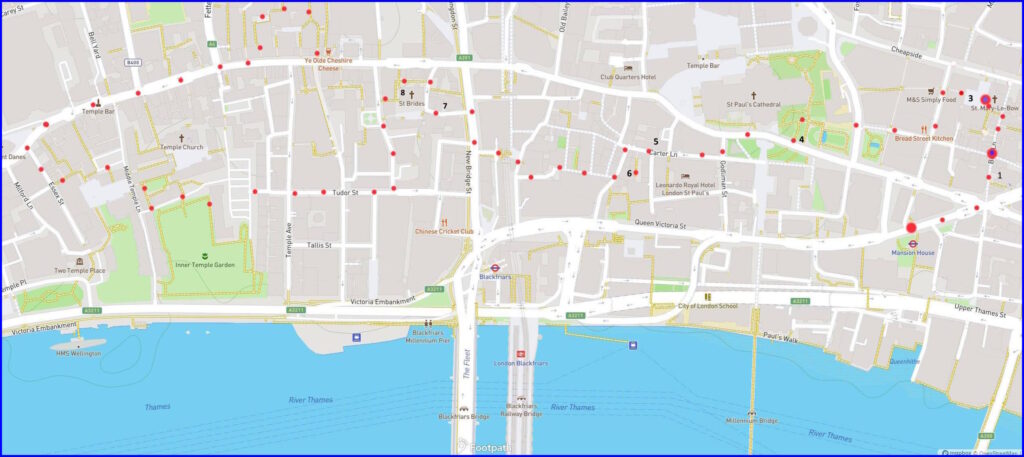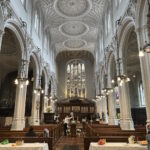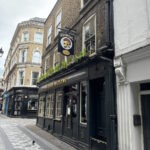The London of Dr. Johnson – i.e., printing, journalism, law. There is a GPX route file. If you don’t know about GPX, don’t download it until you have viewed this explanatory video. This is a great walk to do on a fine Sunday – there will be few people around. The slide show below charts the walk by side arrows. Click any picture to enlarge. Beneath that are notes on points of interest [Back to Walks page]
0: Mansion House Underground
On exiting the underground head towards the 5-way traffic interchange, cross the road and take the narrow Bow Lane that heads north away from the interchange. Immediately notice the tower of a church on the right-hand corner….
1: St Mary Aldermary. Wren Church
A 17th century gothic-revival style church reconstructed by Christopher Wren after the Great Fire of London – although Wren himself may not have had much involvement. Notice the splendid fan vaulting. Victorian furnishing and more recent stained glass.
Don’t miss the Ye Olde Watling pub as you walk forward – created around 1668 by Christopher Wren
3: St Mary-le-Bow church
Another post-fire Wren church (although the foundation goes back to 1080). Famous for its bells (nursery rhymes and Dick Whittington) – if you were born in earshot then you were a true Londoner. It faces the wide Cheapside (= market) There is a balcony from which events below could be watched by dignitaries. The statue in the courtyard is of a famous cordwainer (shoe -maker). Take the alley way near this statue to reach Bread Street and turn left towards the junction with Watling Street. Then walk towards St Pauls.
4: John Donne statue
A 17th century statue of the poet and preacher. He was Dean of St Pauls also and this statue is one of the few remnants of the original St Pauls destroyed by the Great Fire
Drop down onto Canon Street and pick up the left turning into 13th century Carter Lane via Godlimean Street.
5: Victorian Youth Hostel
This used to be the choristers school for St Pauls (they moved in the 1970s). This one built in 1874 to replace on destroyed by the Great Fire. There used to be a cricket pitch on the roof.
6: Wardrobe Place
Drop into this hidden square with its large plane trees. Got its name for being a store facility for royal valuables. Learn more here. Walk down St Andrews Hill to join Ireland Yard. Note the Cockpit pub (a cock fighting history). Shakespeare purchased a house on this site (see plaque).
7: St Brides Foundation
This is the area of the former Blackfriars monastery. Before reaching point 7 you pass the Apothecaries hall a livery company associated with medicines. The St Brides Foundation (1891) established for the print trade nearby and remains a centre for print and design.
8: St Brides Church
Another Wren church (although restored from the original destroyed in the Fire). Long association with Fleet Street, journalism and printing. The church is well worth a visit and, in particular, the crypt which houses an extremely interesting museum covering the printing trade and its associations with the surrounding area.
9: Inner Temple
One of the four Inns of Court (also Middle, Lincoln and Gray). All barristers belong to one of them. A magnificent set of buildings dedicated to legal training. This is land originally that of the Knights Templar – dedicated to defending pilgrims to the Holy Land. The link with law is the historical requirement to deal with the wills of those pilgrims and soldiers who never made it back. The map is not very reliable if you visit on a Sunday as some exit points are closed. So try and keep track of where you are in relation to the main entrance.
Do consider the Olde Cheshire Cheese pub at the end of your walk




























